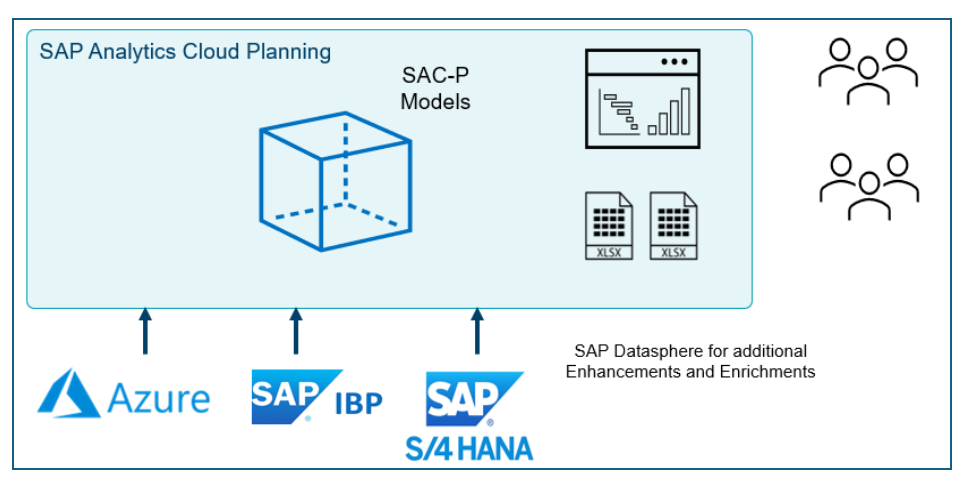At this year’s 2025 SAPinsider conference, we talked with organizations who are leveraging SAP Analytics Cloud Planning (SACP) to transform their financial planning and analysis (FP&A) processes. We were honored to present one client story that details the success companies are realizing using SACP to migrate from legacy platforms like SAP’s Business Planning and Consolidation (BPC).
BPC has been a staple in enterprise performance management (EPM) since its inception as “Outlooksoft,” which SAP acquired in 2007. Initially built on Microsoft technologies, BPC evolved into various versions over the years, including standard and embedded models, each with its strengths and weaknesses. However, as technology progressed, BPC became a monolithic system burdened by technical debt, resembling the mainframe systems of the late 1990s — stable yet stagnant in innovation.
In response to these challenges, SAP introduced SACP in 2015, a cloud-based solution designed to integrate planning, forecasting, reporting and predictive analytics into a single platform. At first, SACP was lacking in functionality compared to BPC and other more mature products since it was built from the ground up. Over time, SACP has closed the functionality gap with BPC, ultimately surpassing it. The question for many organizations is no longer if they should transition, but rather when and how to do so efficiently and cost-effectively.
Real-world example: Transitioning from BPC to SACP
This notable project, led by Protiviti in partnership with a long-term retail client, involved re-implementing legacy BPC systems (ECC and BW) to SACP on S/4HANA. This project encompassed more than 10 years of data across two BPC models (finance and sales margin) supporting a comprehensive set of financial metrics. The project scope also included:
- Replacing or enhancing all existing functionality
- Parallel go-live with SAP S/4HANA
- Support for monthly GAAP close reporting, monthly forecasting and an annual operating plan
- Replacement strategy for 500+ existing reports and 90+ users using SACP reports
- Addition of new processes to streamline inventory management to align with sales and current inventory levels
- Collaborative planning with SAP’s Integrated Business Planning (IBP)
And all was to be accomplished with minimal disruption to the business while also introducing organizational change management to help the impacted users adjust to their new systems.
A phased approach
The project spanned approximately 12 months, encompassing several phases outlined below, facilitating a successful transformation, ultimately leading to enhanced FP&A processes and improved organizational efficiency. Phases included:
Blueprint
The transformation began with a comprehensive blueprint phase, where existing requirements and learnings were captured while aligning with S/4HANA. Although BPC served as the source of data and structures, this phase provided an opportunity to critically evaluate all existing data structures. The team questioned the relevance of data, calculations and reports, effectively conducting a “clean house” exercise to retain only value-added content and remove obsolete elements.
Build and train
In the build and train phase, several key activities took place:
-
- Data loading and initial model build: The BPC connector was utilized to load over 10 years of historical data, establishing a baseline for new SACP models in finance and sales margin.

- Data cleanup: Data and hierarchies were meticulously cleaned up to ensure accuracy and relevance.
- Custom data integration: Custom core data services (CDS) views, using a Protiviti-developed accelerator, were employed to facilitate the loading of data from S/4HANA to SACP, specifically for finance, sales margin, inventory and open purchase orders related to the new open to buy process.
- User empowerment: Power users took the initiative to build reports within SACP, successfully creating over half of the required content to replace the previous 500+ reports.
- Training programs: Comprehensive training sessions were conducted for power users, focusing on advanced functionalities within SACP, including data actions, multi-actions and data integration. These capabilities enabled users to perform complex analyses that were previously reliant on Excel or constrained by BPC’s script logic.
Deployment
During deployment, the final data was loaded from BPC and meticulously mapped to the new SACP structure, ensuring a seamless transition.
Hypercare
The project concluded with hypercare, where the client’s core team members were equipped with the knowledge and tools necessary to manage and maintain the new system effectively. This ensured that any immediate post-deployment issues were addressed promptly, fostering user confidence in the new platform.
Facing challenges with practical solutions
The transition was not without its challenges, ranging from ensuring effective training and adoption among end users, to aligning data definitions and overall process changes with the new system to carefully managing initial performance issues, complex reports and undersized systems.
To address these challenges, the project team employed several strategies:
- Blueprint phase: Engaging key stakeholders early in the design process to align with business requirements.
- End user training: Continuous involvement of users throughout the project to enhance adoption.
- Data conversion strategy: Utilizing a model to load and build data from the existing BPC system while ensuring data tracing and validation.
- Integration: Leveraging custom CDS views and Datasphere for robust data handling.
Reaping the benefits
But while there were challenges, the transition to SACP provided numerous advantages, including enhanced integration with S/4HANA for real-time access to actual GL data, improved calculations and workflows, enabling finance teams to operate more efficiently and quarterly updates to maintain cutting edge functionality.
With the SACP system successfully deployed alongside S/4HANA, new models and data were migrated from BPC and automated integrations for ongoing synchronization with BPC data were implemented. The client now enjoys simplified processes for loading profitability data from S/4HANA and has decommissioned its BPC and BW systems.

The client realized several key takeaways that it now uses in its day-to-day operations:
Organizational change management: Managing the human side of the transformation was crucial.
System design: Proper sizing and thoughtful design of reports and processes are essential to avoid performance issues.
Minimizing Excel add-ins: While reducing reliance on Excel is ideal, flexibility for user needs must be balanced with standardization goals.
The shift from BPC to SACP represents a significant opportunity for organizations to modernize their FP&A processes, streamline operations and leverage advanced analytics. By addressing challenges head-on and implementing practical solutions, companies can successfully navigate this transformation and position themselves for future growth.
To learn more about SACP and our SAP consulting solutions, contact us.





